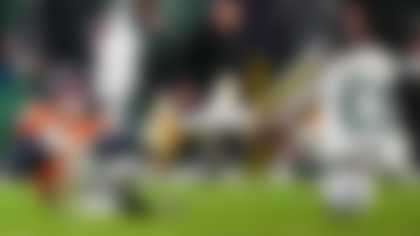It's not a coincidence that stars are a prominent feature of the NFL Shield, because the best teams in the league are keyed by the performances of their star players.
These stars are expected to deliver impact plays on a weekly basis, and their ability to consistently perform at a high level fuels their team's success.
Given the parity that exists throughout the league, teams are rarely able to overcome subpar seasons from their pivotal playmakers. Looking back at the 2009 season, several teams failed to reach the postseason due, at least in part, to the disappointing play of their stars. Regardless of any offseason moves to improve the squad, these teams need their difference-makers to bounce back with better play this season if they want to reach the playoffs.
Let's take a look at five players who must produce in a big way for their teams to make noise in 2010:
David Garrard, QB, Jacksonville Jaguars
The ninth-year pro has to ignite an offense that averaged only 18.1 points per game (24th overall) a season ago. In addition, the Jaguars' pass offense ranked 19th in pass yards and generated just six plays over 40 yards. Although their rush offense, led by Maurice Jones-Drew, ranked among the top 10, the lack of explosiveness in the passing game made the team's offense easy to defend.
While placing the blame on Garrard for the team's offensive woes is slightly off base, the Jaguars need more playmaking from their savvy quarterback to win games in the ultra-competitive AFC South.
He provided those kind of plays in 2007 when he tossed 18 touchdowns with only three interceptions while leading the team to their most recent playoff berth, so it's not out of the realm of possibility to see him orchestrate their offense with superb efficiency.
However, he must get back to avoiding the negative plays that last year routinely kept the Jaguars' offense in long yardage situations. Garrard has taken 42 sacks in each of the past two seasons (compared to only 21 sacks in 2007), and he must find a way to avoid those plays to keep the team's offense on the march.
Whether scrambling for first downs or making plays outside the pocket, Garrard must return to his improvisational ways for the Jaguars to reach their potential.
While he will need his young receivers and offensive line to help him make it happen, Garrard can set the tone for Jack Del Rio's troops by raising his own level of play in 2010.
Brandon Jacobs, RB, New York Giants
The bruising back typically provides the hard-nosed running that Tom Coughlin prefers to establish the tempo of the Giants' offensive attack. Jacobs posted back-to-back 1,000-yard seasons in his first two as a full-time starter and averaged a robust 5.0 yards per carry each year. However, he failed to crack the 1,000-yard mark last year and saw his yards per carry average fall below four yards (3.7) for the first time since his rookie season.
Furthermore, the sixth-year pro seemingly lost his magic for finding paydirt after tallying only five rushing scores a season ago (Jacobs scored 15 touchdowns in 2008).
Consequently, the Giants' powerful rush offense fell to 17th after leading the league in rushing in 2008.
Given Coughlin's mission to recreate the blue-collar mentality that has long embodied the franchise, the onus falls on Jacobs to get the Giants back on track with his bullish running style. If he can regain his punishing form, New York -- which got off to a 5-0 start last year only to fall apart -- could be well on its way to reclaiming a spot among the NFL's elite.
Steve Slaton, RB, Houston Texans
After tearing up the league as a rookie in 2008 with 1,282 rushing yards (1,659 yards from scrimmage), Slaton seemingly disappeared as a playmaker in the Texans' offense during his second season.
He rushed for only 437 yards in 10 starts and failed to surpass the 100-yard mark in any game last season. Though he was counted on to act as their big-play threat, Slaton produced few explosive runs (only three runs over 20 yards after tallying 13 rushes over 20 yards, and five runs over 40 yards, in 2008), and developed a fumbling problem that led to his benching.
In addition, Slaton struggled picking up tough yards in critical situations for the team. While his size naturally limits his impact as a between-the-tackles runner, he didn't display the same vision, quickness and running skills that made him one of the top backs in the league two seasons ago.
If he can settle back into his role as a dynamic multi-purpose weapon while avoiding the big mistakes, Slaton could be the key to the Texans' hopes of winning a division crown.
John Abraham, DE, Atlanta Falcons
The three-time Pro Bowler was virtually invisible as a pass rusher a season ago after ranking as one of the league's top sack artists in 2008 with 16.5. Last season, however, Abraham rarely found the quarterback, and the Falcons' defense suffered as a result. The unit ranked 28th in pass defense, 26th in sacks and 18th in scoring defense, primarily due to Abraham's inability to create consistent pressure on the quarterback.
Though he received little assistance from anyone else along the line, Abraham's dramatic drop-off clearly affected the performance of the Falcons' defense on every level. Quarterbacks had ample time to target the team's young secondary, and the inability to generate pressure with only four rushers prevented the team from getting off the field on third-down situations.
Although a one-man gang is not enough to produce enough pressure for the Falcons to roll into the postseason, the team needs Abraham to re-emerge as a legitimate difference-maker for the defense to provide the offense with enough support to spark a deep postseason run.
Tommie Harris, DT, Chicago Bears
However, Harris rarely displayed that dominance in 2009 and amassed only 2.5 sacks as their "go-to guy" along the line. To make matters worse, the seventh-year pro failed to provide a steady presence against the run and rarely created the disruptive plays that the Bears needed to force opponents into long yardage situations.
With their top defender unable to generate negative plays on a consistent basis, the Bears' defense ranked 22nd in scoring defense (23.4 point per game) and finished in the bottom third of the league in rush defense. Although the Bears still mustered 35 sacks, which ranked 13th overall, Harris' limited contributions as a rusher robbed the unit of its ferociousness.
Given the highly anticipated return of linebacker Brian Urlacher and the addition of defensive end Julius Peppers, the Bears' defense could key the team's resurgence if Harris plays to his potential.




